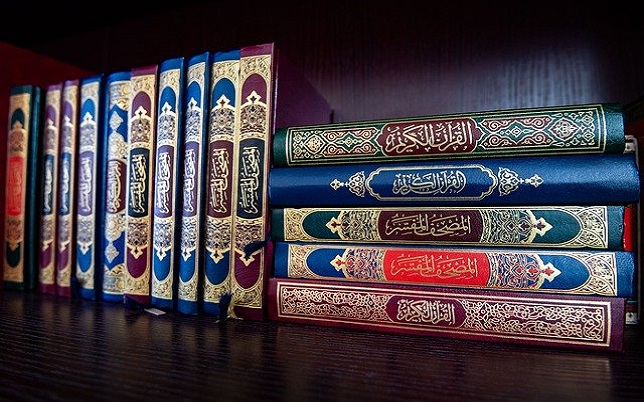Countless Tafseer (commentaries or explanations of Quran) of the Glorious Quran have been written since the blessed period of the Prophethood. In fact, no other book of the world has been served as much as the noble Quran.
Introducing all these famous Quranic commentaries is not possible even in some detailed book, but here the purpose is to give the reader a very brief introduction to Quranic commentaries which are famous throughout the world and are frequently used as references.
Related: Top Islamic beliefs about Quran
Tafseer ibn Jarir
The real name of this Tafseer is Jami al-Bayan and it was compiled by Allamah Abu Ja’far Muhammad ibn Jarir al-Tabari (died 310 Hijrah). Allamah Tabari is a highly rated commentator, muhaddith (hadith expert) and historian.
It is said that he kept writing for forty years continuously and used to write forty pages every day (al-Bidayah wa al-Nihayah ah, v. 11, p 145).
There are charges of being Shiah against him, but researchers have refuted this charge and the truth of the matter is that he is a highly regarded scholar of the followers of the Sunnah, rather one of the Shite scholars.
Being in thirty volumes, his Tafseer enjoys the status of a basic source for later commentaries.
In his explanation of the verses, he quotes different scholars and then goes on to prove the position which, according to him, is weightier, of course, with arguments and proofs.
It must, however, be admitted that narrations of all sorts, sound and weak, have found a place in his commentary. Because of this, not every narration presented by him can be relied upon.
In reality, he was aiming through his commentary to collect and compile all narrations that could become available to him, so that this collected, material could be put to use later on.
Conceded is the fact that he has given the chain of reporters along with each narration so that whoever wishes to investigate into the chain of narrators could do so and decide for himself if the narrations are true or false.
Related: Five pillars of Islam and their meaning
Tafseer ibn Kathir
Hafiz Imad al din Abu al-Fida Ismail ibn Kathir al Damashqi al-Shafii (died 774 Hijrah), a distinguished research scholar of the eighth century, is the author of this commentary. It has been published in four volumes.
Here emphasis has been laid on explanatory narrations. A special feature is his criticism as hadith expert on different narrations, and from this point of view, this book holds a distinct place among all books of Tafseer.
Related: Renowned Quran Tafseers of Deoband ulema
Tafseer Al Qurtubi
Its full name is Al-Jami li-Ahkam al-Quran. It was written by the famous learned writer and research scholar of Andalusia (Spain), Abu Abdullah Muhammad ibn Ahmad Abi Bakr ibn Farah al Qurtubi (died 671 Hijrah). He was a follower of the Maliki school of fiqh and was known all over for his ibadah(worship) and piety.
The fact is that the basic objective of this book was to deduce juristic injunctions and rulings from the Quran yet, while doing so, he has also provided the explanation of verses, research into difficult words, discussion of diacritical marks and elegance of style and composition, and related Traditions and Reports in his Tafseer.
This book is in twelve volumes and has been published repeatedly.
Related: Why Quran was revealed in parts?
Tafseer al Kabir
This is the work of Imam Fakhr al-din al-Razi (died 606 Hijrah). Its real name is Mafatih al-Ghayb, but is popularly known as ‘Tafseer Kabir’.
Imam Razi is an imam of the theology of Islam, therefore, great emphasis has been laid in this Tafseer on rational and scholastic debates and on the refutation of false sects.
But, the truth is that this Tafseer is, in its own way, a unique key to the Quran as well. Furthermore, the pleasing way in which the meanings of the Quran have been clarified and the mutual link of the Quranic verses established, is all too praise-worthy.
Most likely, Imam Razi himself wrote down his Tafseer as far as Surah al-Fath. Onwards from there, he could not complete.
So, the remaining part of the Tafseer, from Surah al-Fath to the end, was completed by Qadi Shihab al Din ibn Khalil al Khawli al Dimashqi (died 639 Hijrah) or Shaykh Najm al Din Ahmad ibn Muhammad al Qamuli (died 777 Hijrah). (Kashaf al-Zunun v 2, p. 477)
Imam Razi has particularly emphasized scholastic debates and the refutation of false sects in accordance with the dictates of his time, and while doing so, his discussions have become too lengthy at several places, therefore, some people have made the following comment on his Tafseer: ‘There is everything in this (book) except the Tafseer.’
But this comment is a terrible injustice to Tafseer Kabir. That which is the truth has already been stated above, namely, that this Tafseer enjoys a high rating as far as the resolution of the meanings of the Quran is concerned.
But, there are places where he has explained verses of the Quran while moving away from the consensus of the ummah, however, such places are very thinly spread out in this book that goes on to eight volumes.
Related: Incredible knowledge of Quran-Keith Moore
Tafsir al Bahr al Muheet
This was written by Allamah Abu Hayyan al Gharnati al Andalusi (died 754 Hijrah) who was a master of syntax and rhetoric in addition to other Islamic fields of learning.
As a result of this, his Tafseer is soaked in syntax and rhetoric. He places special stress on investigating into the words of every verse, the difference in structures and on points of eloquence.
Related: A very important book on Indian Muslims
Ahkaam al Quran by al Jassas
This was written by Imam Abu Bakr al Jassas al Razi (died 370 Hijrah) who occupies a distinguished place among Hanafi jurists.
The deduction of juristic injunctions and rulings from the noble Quran is the subject of this book.
Instead of explaining verses in serial continuity, he has taken up the juristic details as called for by verses which consist of juristic injunctions. Several other books have also been written on this subject, but this book enjoys a prominent place among those.
Related: No one ever was followed like Muhammad-Prof. Philip Hitti
Tafseer al Durr al Manthur
This was written by Allamah Jalal al Din al Suyuti (died 910 Hijrah). Its full name is al-Durr al Manthur fi al Tafseer bil Mathur.
Here Allamah al-Suyuti has tried to collect all narrations about the tafseer of Quran he was able to find.
Several hadith scholars such as Hafiz ibn Jarir, Imam Baghawi, Ibn Marduwayh, Ibn Hibban and Ibn Majah and others had already worked in this area on their own. Allamah al-Suyuti has assembled narrations presented by all of them in this book.
But, rather than refer to complete chain of authorities along with narrations, he has found it sufficient to simply name the particular author who has presented that narration under his authority so that, if needed, one could go back to the work and investigate into the ultimate authority.
Since his purpose was to put together a mass of narrations, as a result of which, all sorts of narrations, sound and weak, have found their way into his book.
Hence, every narration allowed entry by him cannot be considered reliable without investigation into its authority. There are occasions when Allamah al-Suyuti does indicate with each narration the degree of its authority as well.
But, as he is known to be fairly easy-going in respect of hadith critique, it is still difficult to fully rely on that too.
Related: Prophet Muhammad was far ahead of his time
Al Tafseer al Mazhari
This was written by Qadi Thanhullah Panipati (died 1225 Hijrah). He has named this Tafseer as Tafseer al Mazhari after the name of his spiritual master, Mirza Mazhar Jan-e-Janan Dehlavi.
This Tafsir of his is very simple and clear, and extremely useful to locate brief explanations of Quranic verses.
Along with the elucidation of Quranic words, he has also taken up related narrations in ample details, and in doing so, he has made an effort to accept narrations after much more scrutiny as compared with other commentaries.
Related: Prophet Muhammad’s letter to Abyssinian king Najaashi
Ruh al Maani
The full name of this Tafseer is Ruh al-Maani fi Tafseer al-Quran al Azim wa al Sab al Mathani and it was written by Allamah Mahmud al Alusi (died 1270 Hijrah), the famous scholar of the last period of Baghdad, and comprises of thirty volumes.
He has made his best possible effort to make this Tafseer comprehensive.
There are exhaustive discussions on language, syntax, letters, style, and on jurisprudence, articles of faith, scholastics, philosophy, astronomy, mysticism and related narratives of Traditions.
He has made an attempt to leave no intellectual aspect pertaining to a verse unexplained. In the case of hadith narratives as well, the author of this work has been more cautious as compared to other commentators.
From this angle, this is a very comprehensive commentary, and no future venture in connection with the Tafsir of the Quran can now afford to ignore its help.
Recommended:
- Why Islam is the most rational religion?
- 99 names of Allah and their meanings
- Guidelines for naming a Muslim child

